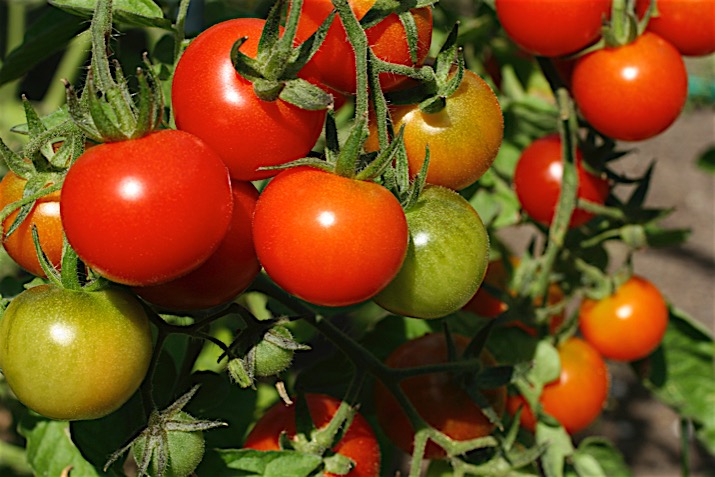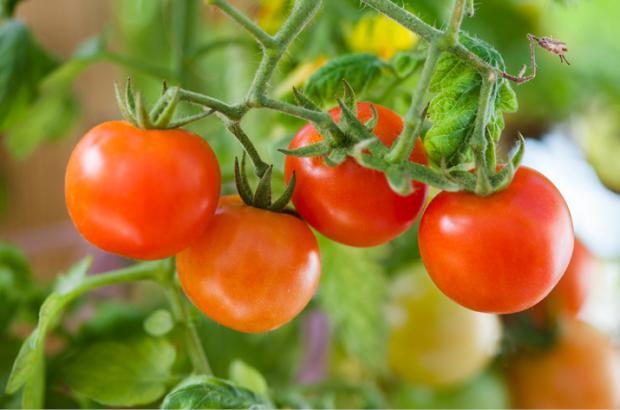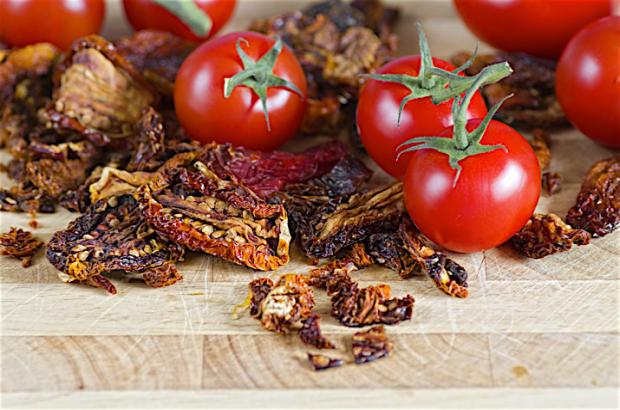Article
Tomatoes

The French and Germans, who first met the tomato in the 16th century, dubbed it "the apple of love," and "the apple of paradise." Our less-romantic name for the fruit dates back further, though, to the Aztecs, who called it "xitomati," or "plump thing with a navel."
Both in Europe and America, it took a while for the tomato to catch on. At first, in fact, it was considered poisonous (the poison turned out to be lead from pewter plates, which was leached by tomatoes' acid). Today, though, this fruit is wildly popular in the United States, with average consumption at about 23 pounds per year per person, mostly via sauces and catsup.
Every U.S. state grows tomatoes, and over 90 percent of home gardeners include tomatoes in their plantings. The largest tomato to date, grown in Oklahoma, weighed over seven pounds and topped enough sandwiches for 21 people. The tallest tomato plant, grown in Lancashire, England reached 65 feet in height.
California and Florida outpace all other states by growing over two-thirds of the tomatoes for fresh consumption, and California grows almost all of the tomatoes that are processed into soups, sauces, catsup, salsa and more. Despite the dominance of these two states in production, tomatoes are celebrated across the country, with 19 states holding tomato festivals each year (find out if your state holds a tomato festival).
According to the USDA, tomatoes are an easy way to boost your intake of the antioxidant lycopene, and they're a very good source of vitamin C, vitamin A, vitamin K, potassium, manganese and dietary fiber. They also provide smaller amounts of vitamin E, thiamin, vitamin B6, folate, magnesium, phosphorus and copper. Incidentally, vine-ripened tomatoes will deliver much more vitamin C than those that were picked green.
There are many thousands of varieties of tomatoes, from small to large, acidic to mild, and an array of colors—including red, yellow, orange, green, purple and brown. Not all tomatoes are round, either. You'll find heirlooms, in particular, in a bevy of shapes and colors, each with subtly different flavors and textures (see Fabulous Must-have Heirloom Tomatoes for some delicious examples). There are three general categories of tomatoes, though: paste, slicing and cherry.
Paste tomatoes have a low water content and thick flesh. Common varieties of paste tomatoes include: Roma, Plum, Saladette, San Marzano and Roman Stripe.
Slicing tomatoes are juicy and flavorful – just perfect for slicing! Common varieties of this type of tomato include: Beefsteak, Early Girl and Big Boy. Heirloom varieties of slicing tomatoes include: Cherokee Purple, German Stripe, Brandywine and Green Zebra.
Cherry tomatoes are small and very sweet. Varieties include: Sweet 100, Grape, Sugar Plum, Sungold, Yellow Pear, Peacevine Cherry and Currant.
Tomatoes enhance almost any savory dish, from soups and salads to casseroles and gratins. And they're delicious raw, baked, grilled, roasted, or cooked into a sauce.
Eggplant, avocado, cucumber, zucchini, squash, green beans, peppers, greens, potatoes… Is there a vegetable that doesn't benefit from the addition of tomatoes? Most cheeses (and especially feta and mozzarella) go well with tomato, as do beef, pork, poultry, fish, tofu and tempeh. At the spice rack, reach for basil, chives, cilantro, cumin, cayenne, garlic, oregano, parsley, rosemary, thyme, marjoram and savory. And for condiments, choose olive oil, balsamic vinegar, mustard, mayonnaise, aioli, and any vinaigrette. Olives, pickles and capers are also good bets.
Tomatoes are standard in salads, of course, but don't stop at lettuce and tomato wedges. Toss sweet red cherry tomatoes together with fresh basil and balls of fresh mozzarella, and sprinkle with balsamic vinegar and olive oil.
Or combine Arugula with Tomatoes and Avocados in Lime Vinaigrette for a lovely Mexican-influenced salad. Top a pizza with some fresh oh-so-ripe tomato slices instead of (or in addition to) tomato sauce.
Tuck thick slices of a ripe heirloom variety into a baguette layered with creamy, tangy goat cheese and peppery arugula. Or try this traditional Tomato Bruschetta that combines fresh Romas, red onions and balsamic dressing.
Tomato soup made with fresh, vine-ripened bounty is unbeatable. Try this lively Strawberry Tomato Gazpacho, which highlights two garden favorites.
Large, ripe tomatoes are the perfect choice for this Stuffed Tomatoes with Pesto and Orzo recipe. If you're lucky enough to have access to green tomatoes, whip up this traditional southern favorite, Fried Green Tomatoes or try this outside-the-box version of Fried Green Tomatoes with Pink Chili Sauce.
Canning is one way to put up an overabundance of ripe tomatoes brought in from the garden or purchased at your co-op or farmers market. Oven-Dried Tomatoes is another, especially suited for fresh paste tomatoes.
Red wines, white wines and both light and dark beers are well served with tomato dishes.
In most areas, you'll find the best supply of fresh tomatoes from July through September. Whenever you can, choose a vine-ripened tomato, because it'll have both the best taste and the highest nutrient content. A ripe tomato should be soft but not mushy; it should yield under pressure. And it should be fragrant. Slightly cracked skins and weird shapes aren't a problem, but avoid leaky tomatoes and those with soft spots and bruises. Select tomatoes that are heavy for their size, with bright coloring.
Once home, don't refrigerate your tomatoes, because cold temperatures will compromise their flavor and texture. Store them at room temperature instead. If you must refrigerate (to keep them from spoiling), remove them half an hour before serving for maximum flavor and juiciness.
Whether you grow your own or bring them home from the market or food co-op, there's no shortage of ways to enjoy the stunning variety of tomatoes.













